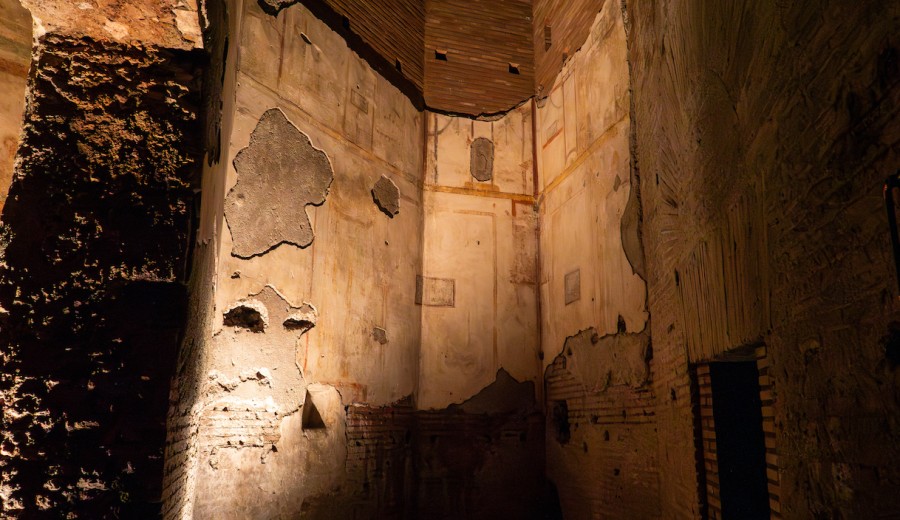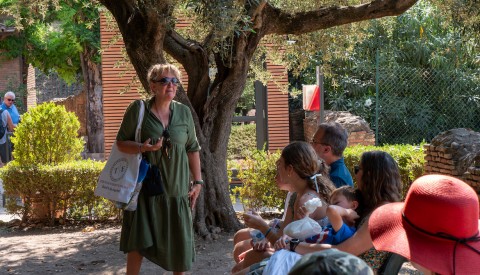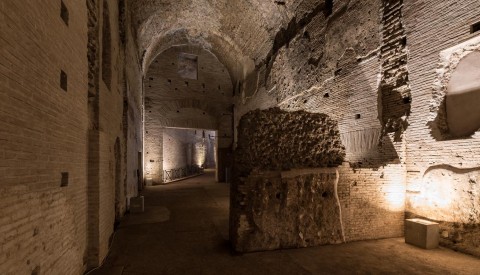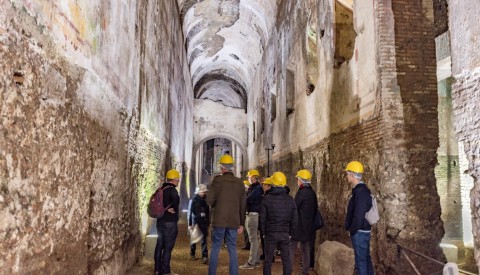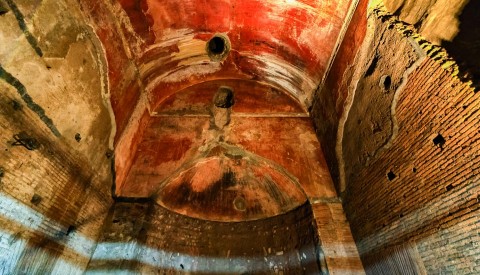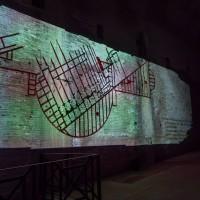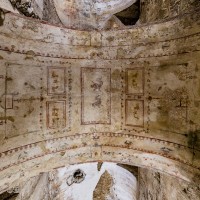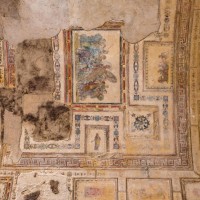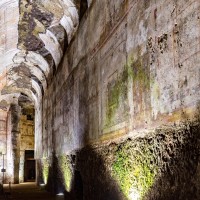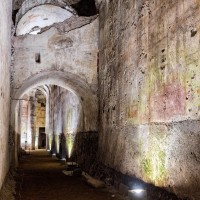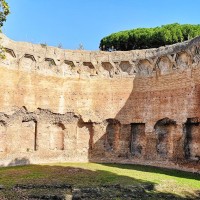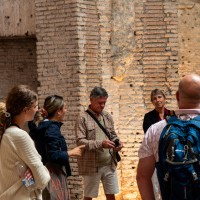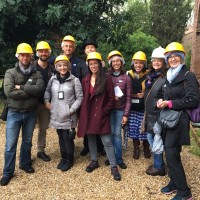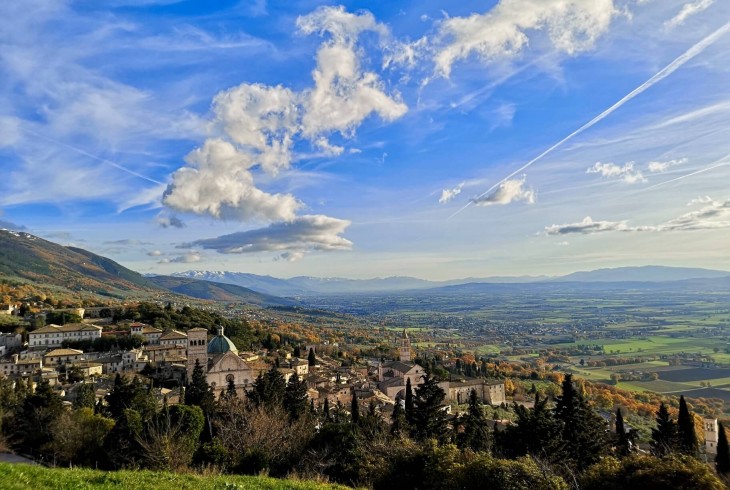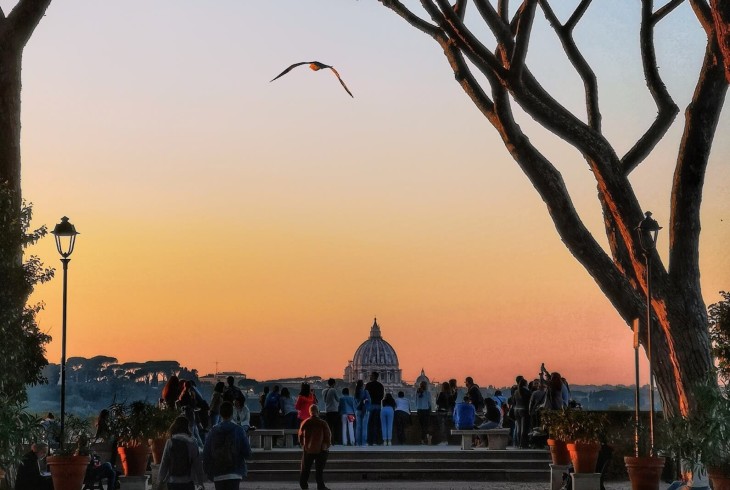Domus Aurea Tour (Nero’s Golden House)
Explore Nero's incredible Golden House and relive the excesses of the ancient emperor
Price 69 €
(128 Reviews)
Domus Aurea Tour (Nero’s Golden House)
duration 2 hours
group size Max. 22
Overview
Descend into the lost world of ancient Rome and relive the opulent life of antiquity’s most notorious emperor on our exclusive tour of Nero’s Golden House. The emperor’s vast palace - known as the Domus Aurea because its every surface glittered with gold – was ancient Rome’s most spectacular building, and scarcely believable highlights included a rotating dining room open to the starry night sky and a massive artificial lake. Nero’s immense party pad was bulldozed and buried to make way for the Colosseum shortly after his suicide, but on this tour you’ll have the unique opportunity to wander its soaring halls again accompanied by an expert archaeologist. We’ll be able to envisage the palace in all its original glory just as it was in the time of Nero himself - keep your eyes peeled and you might just catch a glimpse of his ghost roaming the abandoned halls!
*** All participants 18 and over must book as adults, there is no older student discount available for this itinerary, and due to new regulations for Domus tickets, all participants must provide full names immediately upon booking ***
![]() Tour includes:
Tour includes:
- Exclusive access to the Domus Aurea
- Tickets and reservation fees
- Expert English-speaking archaeologist guide
![]() Highlights:
Highlights:
- Stunning ancient frescoes
- The Octagonal room
- The Room of Achilles and Skyros
- The Room of Hector and Andromache
Description
Discover Ancient Rome's Best Kept Secret
Your tour begins immediately after a brief introduction to the site's historical context provided by our archaeologist. Don your hard hat and you are ready to start your journey!
We offer two special experiences on this tour: an incredible exploration of the colossal spaces of Emperor Nero’s villa, the famous Domus Aurea (Golden House), recently reopened to the public in a remarkable state of conservation, that gives you the chance to relive the splendour of the palace's rooms, gardens and incredible porticos.
We only offer this tour of Nero’s Golden House on Friday, Saturday and Sunday.
The Fascinating History of Nero's Golden House
The Domus Aurea was an enormous complex of buildings, courtyards and gardens that extended from the Palatine Hill to the Esquiline Hill in Rome, covering the whole of the Oppian Hill - that’s an area of over 90 hectares!
Nero's main residence was on the Palatine, and from there an incredible number of buildings branched off which are still connected today via giant underground arcades (such as Nero’s Cryptoporticus, still accessible today and part of his Domus Transitoria on the Palatine Hill, which was destroyed by fire in 64 AD). Much more than a house (domus in Latin), it was a city within a city that unfolded around a vast artificial lake, the Stagnus Neronis (where the Colosseum would later be built). The buildings were surrounded by cultivated land, vineyards, pastures and forests filled with all manner of domestic and wild animals. In the main courtyard of the Domus stood a colossal statue, representing Nero as the Sun God. The pavilions on the Oppian Hill alone consisted of 200 rooms, many of them rediscovered by archaeologists, and which you will explore on our visit to Rome's most exclusive site.
The huge complex of the Domus Aurea was designed for the emperor’s enjoyment in his free time. There he could stroll and feast with guests whilst enjoying beautiful works of art. The Golden House itself is a wonder in terms of architectural elegance and was filled with prized paintings and sculptures, many of which were collected or confiscated by the emperor in various provinces of the Roman empire. Probably among these were the original bronze of the Dying Gaul and the Galatian Suicide, taken from the Acropolis of Pergamon, and the famous statue of the Laocoon, which was found during the Renaissance and today can be found in the Octagonal courtyard of the Vatican Museums. If you want to learn more about this magnificent statue and see it for yourself, check out our Immersive Vatican Museums tour.
Nero undertook the creation of The Domus Aurea after the terrible fire of July 64 AD, which blazed for nine days and destroyed as many as 10 of the 14 districts into which the city was divided. The damage was extensive, and many perished. According to legend, Nero enjoyed the spectacle of Rome in flames, which reminded him of the destruction of Troy. However nothing could be further from the truth - his own Domus Transitoria was badly damaged and historical sources tell us that the emperor returned quickly from Anzio to Rome - about 70 km away - to coordinate relief efforts. Nevertheless, his enemies spread the word that Nero himself had started the fire in the Circus Maximus and from there it was simply unstoppable. Most likely to create a scapegoat for himself, Nero blamed the Christians and instigated one of the most famous and bloody persecutions in history. Among the murdered Christians, the apostle Peter was crucified; centuries later, the site of his burial would become St. Peter’s Basilica.
Incredible Architecture and Jaw-Dropping Frescoes
Nero entrusted the project of his Golden House to his renowned architects, Severus and Celer. The works were completed at an incredible speed, with many of the contructions being completed in just 4 years. The remarkable life of Nero came to an end in 68 AD, when Nero committed suicide before the army and the Senate could find him to sentence him to death for killing his mother, Agrippina, and his wife. Despite Nero’s immensely controversial life, he was proud of the achievement of the Domus: the ancient historian Suetonius cited him as saying: "Good, now I can at last begin to live like a human being. He died shortly after, aged just 31.
Suetonius described the rooms as follows: parts of the house were overlaid with gold and studded with precious stones and mother of pearl. All the dining rooms had ceilings of fretted ivory, the panels of which could slide back and let a rain of flowers, or of perfume from hidden sprinklers, fall on his guests. The main dining room was circular, and its roof revolved slowly, day and night, in time with the sky. Seawater, or sulfur water, was always on tap in the baths.
Suetonius coined the name of the Domus Aurea (Golden House) because "everything was covered with gold and covered with precious stones and shells." The most impressive spaces of the Domus Aurea are unquestionably the various rooms and courtyards, many of which have been completely restored and are part of our unique tour.
Wander through the incredible halls of Nero's pleasure palace
Our Domus Aurea tour starts in what was a huge porch with columns; we then move on to a grotto containing a large bath with a small waterfall - even though the space is covered, it is anything but dark. Light enters from the side windows of the porch: accentuated in the changing reflections of the water, it bounces off alabaster walls and ceilings and creates a wondrous light, much like a spotlight on a river. Here we're close to the original pentagonal courtyard, which is remarkable in terms of size and structure, and just a stone’s throw from the lush gardens. From here the tour continues to the east wing of the Golden House, where the architects Severus and Celer reached the pinnacle of their trade in the Octagonal Room, the architectural heart of the complex. We'll pause for a moment before admiring the two adjacent rooms: the Room of Achilles and Skyros and that of Hector and Andromache, absolute treasure-troves of brilliantly preserved frescoes.
Next, we proceed to admire the most exclusive of all the spaces: the Octagonal Hall itself, where the magnificence of Nero’s palace never fails to leave us stunned. Our gaze is automatically drawn to the ceiling which is perforated by the form of an open eye that would have revealed an infinite expanse of space filled with stars. From this romantic and ingenious viewpoint, Nero’s fortunate guests would lie on couches and feast whilst admiring the cosmos and the works of art in the centre of the room. This incredibly ambitious structure was a unique innovation in Roman architecture, and it is no coincidence that it became a model to be emulated - such as in the majestic Pantheon.
Read more on our blog: Nero's House of Gold and his eccentric life
Buried, Forgotten and Rediscovered: The Domus Aurea after Nero
After the death of Nero, a time of political instability followed. The emperor Vespasian firmly took hold of the reins of empire, and headed in a new direction with his government. The gardens of the Domus Aurea, disliked by the people and the senators as a symbol of Nero’s clear abuses of power and waste of money, were returned to the Romans. In just ten years the site of the original artificial lake of the Domus was transformed into a huge amphitheatre, inaugurated by Vespasian's son and new emperor Titus in the year 80 AD to host gladiator battles, which by then were very popular throughout the empire. The giant statue of Nero, created in the image of the Sun God, was moved near the entrance of the amphitheatre using 24 elephants! It was from this colossal likeness that the adjacent amphitheatre took its name - the Colosseum.
Over the coming decades the emperor Trajan successfully inflicted lasting damage to the posthumous memory of Nero, damning his name and ordering the destruction of any artifact bearing his name or image. The Domus Aurea was buried by the majestic Baths of Trajan; the Domus Aurea, a kingdom of light, was scattered and cast into the shadows where it became a kingdom of darkness.
It was only in the early 1500s that interest in the Domus was reawakened, thanks to the irrepressible passion for ancient texts and remnants that animated the culture of the Renaissance. Renaissance artists often braved dangerous conditions and ventured on nocturnal expeditions into these damp tunnels, looking for evidence of Rome's past. The most noble among these expeditioners was the Umbrian painter Pinturicchio, handsomely rewarded by the Borgia pope Alexander VI for decorating his apartments in the Vatican palace. Torch in hand, he ventured into the Domus' caves accompanied by Raphael and his assistants, where they studied and sketched the strange tangled forms and bizarre figures they saw in its frescoes. Inspired by these underground journeys, he reproduced what he saw in many of the Renaissance palaces he was hired to decorate. The artists' signatures are still engraved on the ancient ruins, and our archaeologist will help you to locate them and appreciate their meaning.
Amazing 3-D Animations on our Domus Aurea Tour
What we offer on this guided tour is a real Roman journey to discover the city's ancient splendour - a voyage into both the palace's physical remains and virtual recreations of what has been lost, bridging the gap between modern times and the days of Nero. Thanks to today’s technology, we can superimpose a virtual reality of the past onto the incredible ruins of the Domus Aurea - thick walls traversed by light flooding in from arcades, and beautiful fountains tinkling merrily in porches beyond. Even the palace's fragmentary frescoes are recreated in their entirety, and in their splendidly vivid colours we can admire the famous "grotesque" style that captivated the Renaissance artists who ventured into its dark tunnels, at first with no idea of where they were. Thanks to these virtual recreations, today we can appreciate Nero's love of art and the striking works housed within his Domus Aurea as never before - indeed, as only the emperor Nero himself and a few select guests enjoyed it in the past. For Nero’s palace was designed for the pleasure of only one man: himself. Once a palace of light before it was cast into centuries of darkness, today it is again illuminated, throwing its rays onto porches and windows, onto marbles and precious gems that endlessly fragment and disperse their light. You will see what Nero saw as you stroll unnoticed through his great palace. As you do you can almost feel a foreboding presence, threatening and lost in distant steps that echo down the centuries.
After your two hour tour you will have a new knowledge of Ancient Rome, taking home not only beautiful photos but also great memories of a truly unique experience.
Cancellation Policy
Cancel up to 24 hours in advance for a full refund, minus any ticket costs.Reviews
5.0 (128 reviews)
Very good, I would be delighted if the tour were also available in German.
The tour was fascinating if you like historical excavations and that kind of thing as well. The VR portion of the tour only lasts a few minutes and while it was pretty amazing, don’t book mainly for that.

From our Blog
In the Footsteps of Saint Francis: What to See in Assisi
Spectacular Assisi blends art, faith, and history in perfect harmony. From Giotto’s frescoes to amazing views, it’s an unmissable stop in the heart of Umbria.
Wed 08 Oct 2025
What to See on the Aventine Hill in Rome
Discover the Aventine Hill in Rome and explore panoramic gardens, historic churches, and hidden keyholes with our guide!
Wed 10 Sep 2025
Celebrating Ferragosto: Italy’s August Holiday
Find out all you need to know about Ferragosto, the Italian summer holiday that takes place every year on August 15th.
Thu 14 Aug 2025
69 €
